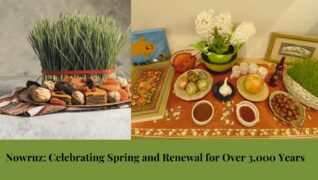Celebrating Nowruz Around the World
Every year on the spring equinox, cultures across the Northern Hemisphere celebrate the arrival of spring with various traditions and festivities. Among these celebrations is Nowruz, the Persian New Year, a vibrant and ancient festival with a rich history and deep cultural significance.
A New Day Dawns: The Meaning Behind Nowruz
Nowruz, which translates to “new day” in Farsi, marks the beginning of spring and the Iranian Solar Hijri calendar. It typically falls between March 19th and March 21st, coinciding with the vernal equinox – the day when daylight and darkness are roughly equal in length. This astronomical phenomenon signifies a turning point in the seasons, symbolizing renewal, rebirth, and the start of a fresh cycle.
A Celebration Steeped in History
Nowruz boasts a history exceeding 3,000 years, tracing its roots back to ancient Iran (known then as Persia). Celebrated for millennia, it has become deeply embedded in the cultural heritage of the Iranian plateau and neighboring regions. The rich traditions and symbolism associated with Nowruz earned it recognition by UNESCO as an Intangible Cultural Heritage of Humanity.
Over time, Nowruz spread beyond its origins, traveling along the Silk Road trade routes. Today, it’s a cherished celebration for people of diverse religions and ethnicities across Central Asia, the Middle East, and even parts of the Balkans. This widespread observance highlights the unifying power of Nowruz, transcending cultural and religious boundaries.
A Time for Traditions: Welcoming Spring with Rituals and Delights
The festivities of Nowruz are steeped in tradition, creating a joyous and meaningful experience for celebrants. Here are some key highlights of how people celebrate Nowruz:
-
Khooneh Tekooni (Spring Cleaning): In the weeks leading up to Nowruz, homes undergo a thorough cleaning, both physically and metaphorically. This “spring cleaning” ritual, known as Khooneh Tekooni, symbolizes the removal of negativity and the creation of a clean and fresh space to welcome the new year.
-
Haft-Sin (The Seven S’s): A central element of this celebrations is the Haft-sin, a special table setting featuring seven symbolic items whose names all begin with the letter “sin” in Farsi. Each item carries a specific meaning, representing such concepts as:
- Rebirth (Sabzeh) – sprouted wheat or lentils
- Health (Sabzi) – fresh herbs
- Prosperity (Samanu) – a sweet wheat pudding
- Patience (Senjed) – dried lotus fruit
- Beauty (Sir) – garlic
- New beginnings (Seeb) – apples
- Coins (Sekkeh) – symbolizing wealth and prosperity
-
Family Gatherings and Gift-Giving: It is a time for strengthening family bonds and fostering social connections. Families gather for joyous celebrations, exchange gifts, and enjoy delicious meals featuring traditional Nowruz dishes like sabzi polo (herbed rice) and fish.
-
Fireworks and Festivities: Depending on the region, celebrations might also include jumping over bonfires to symbolically cleanse oneself and ward off evil spirits. Traditional dances, music, and vibrant decorations further enhance the festive atmosphere.
A Legacy of Unity and Renewal
Nowruz is more than just a celebration of spring; it’s a time for reflection, renewal, and strengthening bonds with loved ones. The traditions associated with Nowruz promote peace, solidarity, and respect for different cultures. In 2010, the United Nations officially recognized the International Day of Nowruz, further solidifying its role in fostering global unity and cultural exchange.
Nowruz serves as a reminder of the enduring power of traditions and the importance of celebrating the beauty of nature’s cycles. As people around the world welcome the arrival of spring, the vibrant spirit of Nowruz continues to bring joy, hope, and a sense of renewal for millions.
FAQs:
- What does Nowrooz: mean?
Nowrooz translates to “new day” in Farsi and marks the Iranian New Year and the beginning of spring.
- When is Nowrooz: celebrated?
Nowrooz falls on the spring equinox, typically between March 19th and March 21st.
- What are some key traditions of Nowrooz: ?
Spring cleaning, Haft-sin (symbolic table setting), family gatherings, and festive meals are central traditions.
- How long has Nowrooz: been celebrated?
Nowrooz boasts a rich history exceeding 3,000 years.
- Why is Nowrooz: significant?
Nowrooz celebrates renewal, unity, and cultural exchange.
Other link:
Wales marks a historic moment as Vaughan Gething becomes the first Black leader of the country — a major milestone in its political journey. 👉 Read the full story on Vaughan Gething’s groundbreaking appointment as Wales’ First Minister
✅ 2. Google Doodle Evolution:
From fun sketches to powerful tributes, the evolution of Google Doodle reveals how it became a global cultural symbol. 🎨 👉 Explore how Google Doodles have transformed into a worldwide celebration of creativity and heritage

